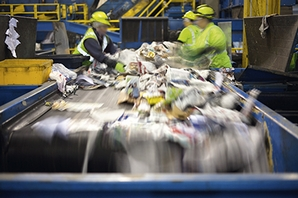New plastics recycling initiatives raise old questions in Europe – January 2018 has seen a slew of new initiatives for reducing the use of plastic and increasing plastic recycling – Plastics recycling Europe - Arhive
Plastics recycling Europe Plastics recycling Europe Plastics recycling Europe Plastics recycling Europe Plastics recycling Europe Plastics recycling Europe Plastics recycling Europe Plastics recycling Europe Plastics recycling Europe Plastics recycling Europe
New plastics recycling initiatives raise old questions in Europe
London (Platts)-
January 2018 has seen a slew of new initiatives for reducing the use of plastic and increasing plastic recycling.
 However, with these announcements old questions concerning collection and recycling capacity have resurfaced and will have to be addressed if new targets are to be met.
However, with these announcements old questions concerning collection and recycling capacity have resurfaced and will have to be addressed if new targets are to be met.
January 16 saw the European Commission announce the first pan-Europe strategy on plastics, with the aim of making all plastic packaging in the EU recyclable by 2030 and moving towards an increasingly circular economy, with less use of single-use plastics.
The new strategy aims to increase demand for recycled plastics, improve and standardize waste product collection and sorting, and improve recycling facilities.
The strategy was welcomed by industry body Plastics Recyclers Europe, which said: “Concrete actions and commitments are needed from all the industry actors, as well as the public authorities and citizens. Collective efforts will bear fruit to the goals set by the much-needed Plastics Strategy.”
Among the most high-profile new commitments were those made by US soft drinks giant Coca Cola January 19, when it announced a new international aim to make bottles with an average recycled content of 50% by 2030 and to help in the collection and recycling of the equivalent of 100% of its packaging by the same date. This aim would mean collecting one bottle for every can or bottle sold.
This followed a 2017 initiative to ensure Coca-Cola’s plastic bottles in the UK contain a minimum of 50% recycled material by 2020.
Danone, meanwhile, has announced plans to make all plastic bottles for its Evian bottled water from 100% recycled plastic by 2025. To reach this aim, the company will look into redesigning Evian packaging and improving recycling initiatives.
According to the company, Evian bottles currently contain an average of around 25% recycled polyethylene terephthalate.
While PET, the plastic used to make Coca Cola and Evian bottles, remains the most recycled plastic, moving towards a more circular economy will also mean encouraging the recycling of other plastics such as high-density polyethylene and polypropylene.
According to the association of plastics manufacturers, Plastics Europe, although 27.1 million mt of plastic waste was collected in the EU28, Switzerland and Norway during 2016, only 31.1% was recycled, of which 37% was processed outside the EU.
Nevertheless, according to Plastics Europe, the amount of plastic waste collected for recycling rose 79% between 2006-2016.
On January 16, alongside the European Commission, six plastics industry organizations committed to launch new platforms with the aim of recycling 50% of plastics waste by 2040.
The organizations involved in this initiative are VinylPlus, Petcore Europe, Plastics Recyclers Europe, European Carpet and Rug Association, European Plastics Converters and Polyolefin Circularity Platform.
NEW CAPACITY
Market participants have realized that in order to achieve the aim of moving towards a more closed loop economy new recycling facilities will have to be developed.
“Building additional recycling capacity is inevitable and there is bound to be a reaction, although these things take time and to speed up the process we could see acquisitions,” a recycler said Wednesday.
While it remains to be seen what new investments in capacity are announced as the wider recycled plastics market reacts to the increasing focus on recycling, early 2017 has already seen some progress on this front.
On January 15, Dutch recycler Morssinkhof Rymosplast Group announced plans to build a new recycling plant in Heerenveen in the Netherlands.
According to the company, the site, which will be able to save 20,000 mt of carbon dioxide a year, is expected to start operating during 2019 and will process waste HDPE and post-consumer PP.
One of the stated aims of the European Commission’s new strategy on plastic waste is to improve the profitability of recycling for business and the development of this aim could be key to the wider move towards a more closed loop economy in Europe.
In the past recyclers of PET have struggled to remain competitive in periods of low virgin PET pricing. However, increased public scrutiny is also expected to play a role in achieving the aim of making recycling more profitable for business.
One recycler, speaking about the new initiatives launched throughout January said: “They are stealing the headlines and once the packaging is designed they cannot come and go, although when prices come into play they could use a little less [R-PET].”
–Luke Milner, luke.milner@spglobal.com
–Antoine Simon, antoine.simon@spglobal.com
–Edited by Jonathan Loades-Carter, jonathan.carter@spglobal.com
Related Topics
Plastics recycling Europe Plastics recycling Europe Plastics recycling Europe Plastics recycling Europe Plastics recycling Europe Plastics recycling Europe Plastics recycling Europe Plastics recycling Europe Plastics recycling Europe Plastics recycling Europe
